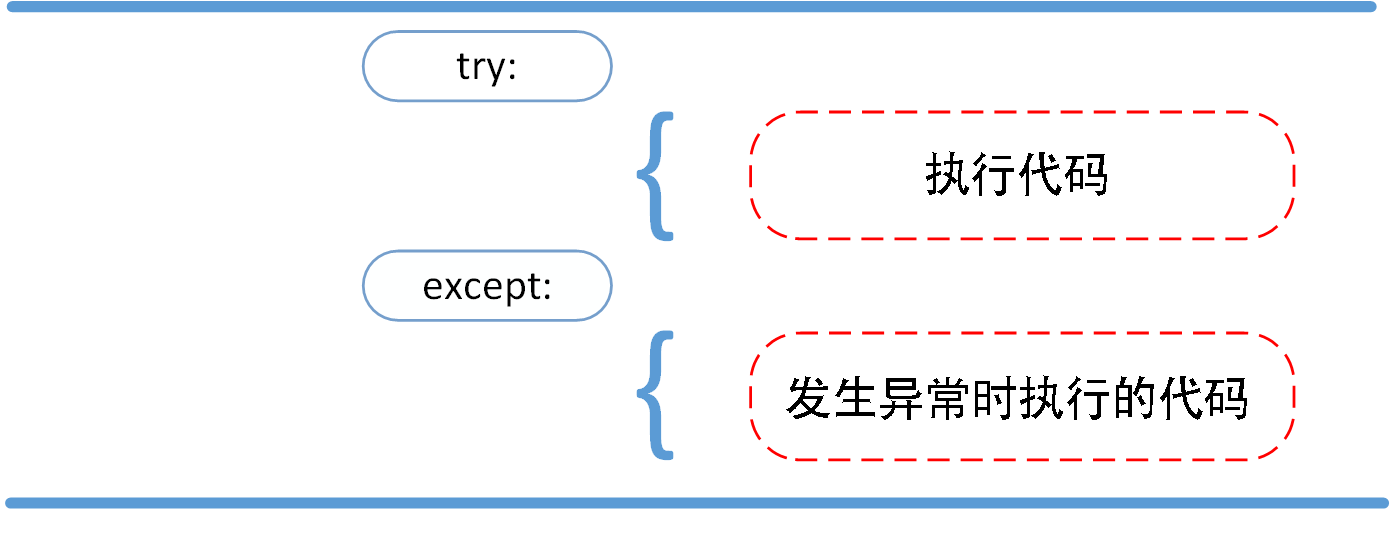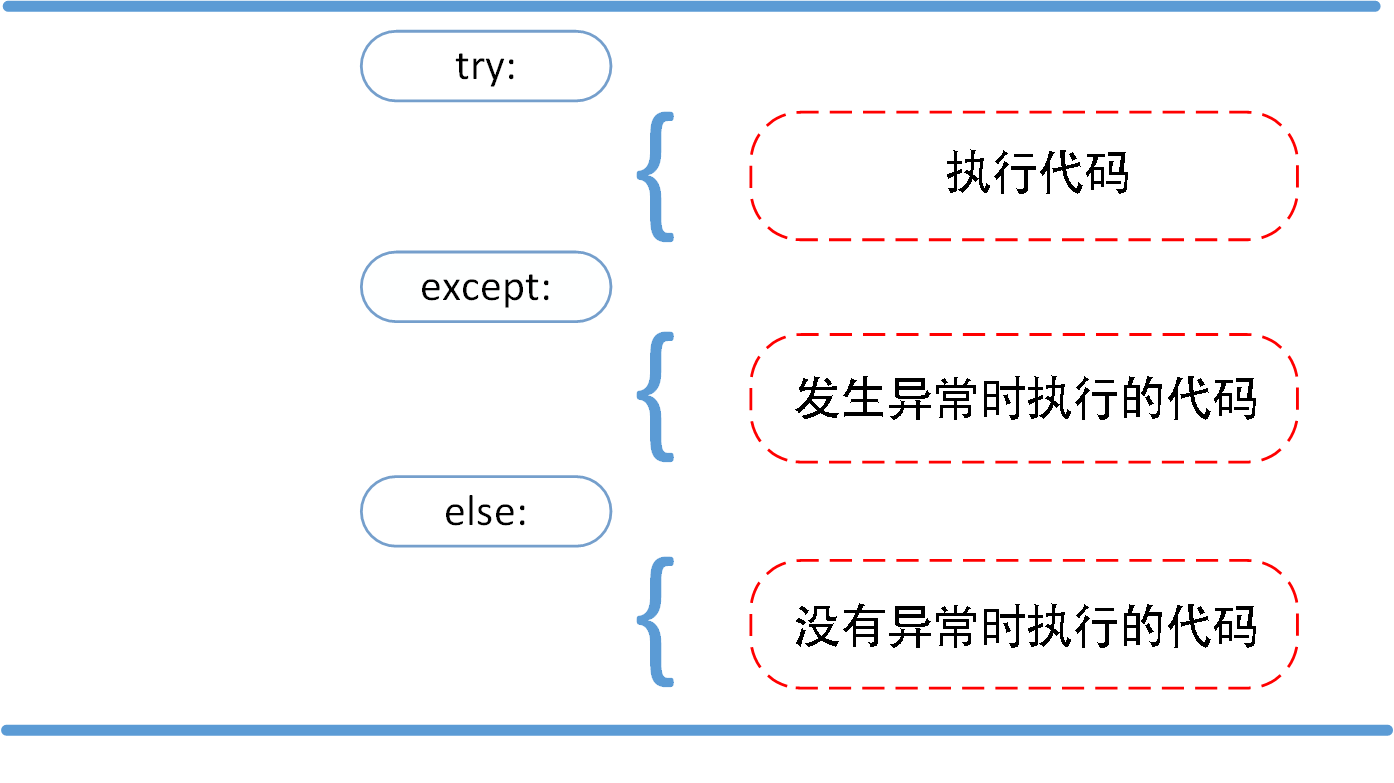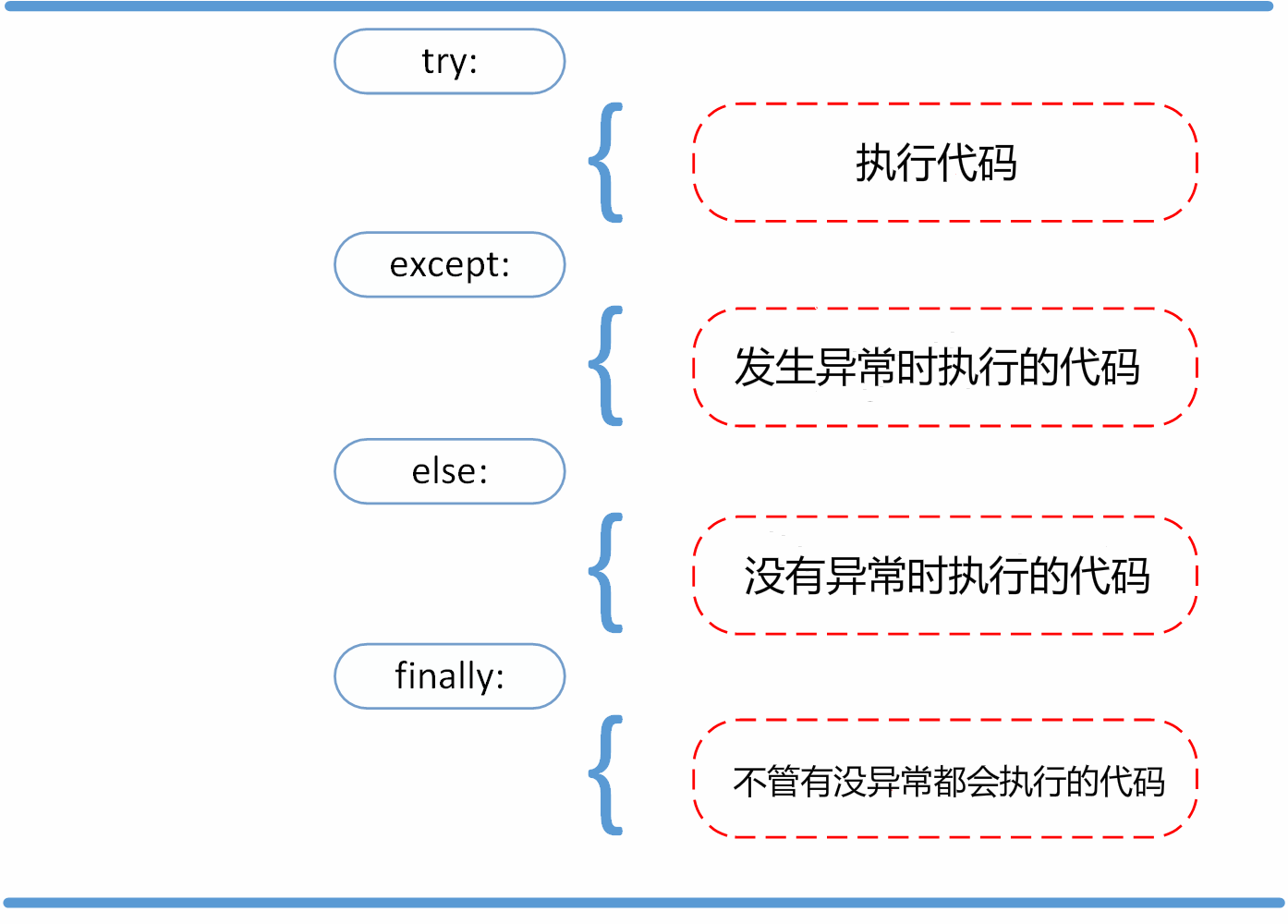Python 有两种错误:语法错误和异常。
Python assert(断言)用于判断一个表达式,在表达式条件为 false 的时候触发异常。
异常处理 try/except
1 2 3 4 5 6 while True : try : x = int (input ("请输入一个数字: " )) break except ValueError: print ("您输入的不是数字,请再次尝试输入!" )
一个except子句可以同时处理多个异常,这些异常将被放在一个括号里成为一个元组,例如:
1 2 except (RuntimeError, TypeError, NameError): pass
try/except…else
try-finally 语句
抛出异常 Python 使用 raise 语句抛出一个指定的异常。
raise语法格式如下:
1 raise [Exception [, args [, traceback]]]
raise 唯一的一个参数指定了要被抛出的异常。它必须是一个异常的实例或者是异常的类(也就是 Exception 的子类)。
如果你只想知道这是否抛出了一个异常,并不想去处理它,那么一个简单的 raise 语句就可以再次把它抛出。
1 2 3 4 5 try : raise NameError('HiThere' ) except NameError: print ('An exception flew by!' ) raise
用户自定义异常 通过创建一个新的异常类来拥有自己的异常。异常类继承自 Exception 类,可以直接继承,或者间接继承,大多数的异常的名字都以”Error”结尾,跟标准的异常命名一样。例如:
1 2 3 4 5 6 7 8 9 10 >>> class MyError (Exception ): def __init__ (self, value ): self.value = value def __str__ (self ): return repr (self.value) >>> try : raise MyError(2 *2 ) except MyError as e: print ('My exception occurred, value:' , e.value)
在这个例子中,类 Exception 默认的 __init__() 被覆盖。
当创建一个模块有可能抛出多种不同的异常时,一种通常的做法是为这个包建立一个基础异常类,然后基于这个基础类为不同的错误情况创建不同的子类:
1 2 3 4 5 6 7 8 9 10 11 12 13 14 15 16 17 18 19 20 21 22 23 24 25 26 27 28 29 30 class Error (Exception ): """Base class for exceptions in this module.""" pass class InputError (Error ): """Exception raised for errors in the input. Attributes: expression -- input expression in which the error occurred message -- explanation of the error """ def __init__ (self, expression, message ): self.expression = expression self.message = message class TransitionError (Error ): """Raised when an operation attempts a state transition that's not allowed. Attributes: previous -- state at beginning of transition next -- attempted new state message -- explanation of why the specific transition is not allowed """ def __init__ (self, previous, next , message ): self.previous = previous self.next = next self.message = message
定义清理行为 如果一个异常在 try 子句里(或者在 except 和 else 子句里)被抛出,而又没有任何的 except 把它截住,那么这个异常会在 finally 子句执行后被抛出。
1 2 3 4 5 6 7 8 9 >>> try :... raise KeyboardInterrupt... finally :... print ('Goodbye, world!' )... Goodbye, world! Traceback (most recent call last): File "<stdin>" , line 2 , in <module> KeyboardInterrupt
预定义的清理行为 关键词 with 语句就可以保证诸如文件之类的对象在使用完之后一定会正确的执行他的清理方法:
1 2 3 with open ("myfile.txt" ) as f: for line in f: print (line, end="" )
捕获所有异常 1 2 3 4 5 try : ... except Exception as e: ... log('Reason:' , e)
这个将会捕获除了 SystemExit 、 KeyboardInterrupt 和 GeneratorExit 之外的所有异常。 如果你还想捕获这三个异常,将 Exception 改成 BaseException 即可。
内置异常 BaseException为所有异常的基类,其下面分为:SystemExit、KeyboardInterrupt、GeneratorExit、Exception 四类异常,Exception 为所有非系统退出类异常的基类,Python 提倡继承 Exception 或其子类派生新的异常;Exception 下包含我们常见的多种异常如:MemoryError(内存溢出)、BlockingIOError(IO异常)、SyntaxError(语法错误异常)… 详细说明可以查看下面列表:
1 2 3 4 5 6 7 8 9 10 11 12 13 14 15 16 17 18 19 20 21 22 23 24 25 26 27 28 29 30 31 32 33 34 35 36 37 38 39 40 41 42 43 44 45 46 47 48 49 50 51 52 53 54 55 56 57 58 59 60 61 62 63 64 BaseException +-- SystemExit +-- KeyboardInterrupt +-- GeneratorExit +-- Exception +-- StopIteration +-- StopAsyncIteration +-- ArithmeticError | +-- FloatingPointError | +-- OverflowError | +-- ZeroDivisionError +-- AssertionError +-- AttributeError +-- BufferError +-- EOFError +-- ImportError | +-- ModuleNotFoundError +-- LookupError | +-- IndexError | +-- KeyError +-- MemoryError +-- NameError | +-- UnboundLocalError +-- OSError | +-- BlockingIOError | +-- ChildProcessError | +-- ConnectionError | | +-- BrokenPipeError | | +-- ConnectionAbortedError | | +-- ConnectionRefusedError | | +-- ConnectionResetError | +-- FileExistsError | +-- FileNotFoundError | +-- InterruptedError | +-- IsADirectoryError | +-- NotADirectoryError | +-- PermissionError | +-- ProcessLookupError | +-- TimeoutError +-- ReferenceError +-- RuntimeError | +-- NotImplementedError | +-- RecursionError +-- SyntaxError | +-- IndentationError | +-- TabError +-- SystemError +-- TypeError +-- ValueError | +-- UnicodeError | +-- UnicodeDecodeError | +-- UnicodeEncodeError | +-- UnicodeTranslateError +-- Warning +-- DeprecationWarning +-- PendingDeprecationWarning +-- RuntimeWarning +-- SyntaxWarning +-- UserWarning +-- FutureWarning +-- ImportWarning +-- UnicodeWarning +-- BytesWarning +-- ResourceWarning
BaseException 所有异常的基类
SystemExit 解释器请求退出
KeyboardInterrupt 用户中断执行(通常是输入^C)
Exception 常规错误的基类
StopIteration 迭代器没有更多的值
GeneratorExit 生成器(generator)发生异常来通知退出
StandardError 所有的内建标准异常的基类
ArithmeticError 所有数值计算错误的基类
FloatingPointError 浮点计算错误
OverflowError 数值运算超出最大限制
ZeroDivisionError 除(或取模)零 (所有数据类型)
AssertionError 断言语句失败
AttributeError 对象没有这个属性
EOFError 没有内建输入,到达EOF 标记
EnvironmentError 操作系统错误的基类
IOError 输入/输出操作失败
OSError 操作系统错误
WindowsError 系统调用失败
ImportError 导入模块/对象失败
LookupError 无效数据查询的基类
IndexError 序列中没有此索引(index)
KeyError 映射中没有这个键
MemoryError 内存溢出错误(对于Python 解释器不是致命的)
NameError 未声明/初始化对象 (没有属性)
UnboundLocalError 访问未初始化的本地变量
ReferenceError 弱引用(Weak reference)试图访问已经垃圾回收了的对象
RuntimeError 一般的运行时错误
NotImplementedError 尚未实现的方法
SyntaxError Python 语法错误
IndentationError 缩进错误
TabError Tab 和空格混用
SystemError 一般的解释器系统错误
TypeError 对类型无效的操作
ValueError 传入无效的参数
UnicodeError Unicode 相关的错误
UnicodeDecodeError Unicode 解码时的错误
UnicodeEncodeError Unicode 编码时错误
UnicodeTranslateError Unicode 转换时错误
Warning 警告的基类
DeprecationWarning 关于被弃用的特征的警告
FutureWarning 关于构造将来语义会有改变的警告
OverflowWarning 旧的关于自动提升为长整型(long)的警告
PendingDeprecationWarning 关于特性将会被废弃的警告
RuntimeWarning 可疑的运行时行为(runtime behavior)的警告
SyntaxWarning 可疑的语法的警告
UserWarning 用户代码生成的警告
参考:
内置异常
Python3 错误和异常



